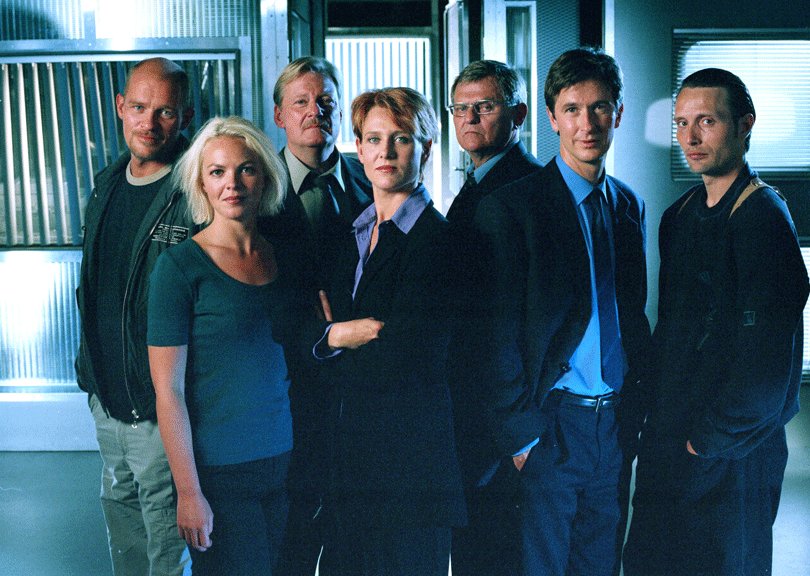
Introduction
Danish audio-visual drama series are currently experiencing an unprecedented global boom in exports: especially series from the main public broadcaster DR – such as Forbrydelsen (The Killing, DR1, 2007-2012), Borgen (DR1, 2010-13) and Bron/Broen (The Bridge, SVT1/DR1, 2011-present) – a co-production with Swedish public broadcaster SVT and two independent production companies, broadcast simultaneously on Swedish and Danish TV. These three series have been exported on a truly global scale, with more recent series following the same trend: Arvingerne (The Legacy, 2014-15, DR1), Norskov (TV2, 2015), and Bedrag (Follow the Money, DR1, 2016). Through a historical analysis of importing countries and channels of five of DR’s drama series – namely Rejseholdet (Unit One, DR1, 2000-2004), Ørnen (The Eagle, DR1, 2004-2006), The Killing, Borgen and The Bridge – this article maps the export patterns of the series over the last 15 years in order to hypothesise on the global impact of the series. The analysis points to the fact that the recent series (The Killing, Borgen and The Bridge) have been exported more or less globally, whilst the older series (Unit Oneand The Eagle) were mainly exported regionally, in a cultural and geo-linguistic sense, and to countries with democratic-corporatist media systemic features in their broadcasting systems. Furthermore, there are clear indications that the further the series move away from Denmark (both in regards to culture, geo-linguistic regions and media systemic models), the more ‘niche’, quantitatively speaking, the importing channels become. This does not mean, however, that the series do not have an impact because the foreign channels that have acquired the drama series in question tend to appeal to audiences that are likely to include the more influential and trendsetting segments of the population; that is, the segments with a high cultural, intellectual and possibly financial capital. In conclusion, I argue that in order to fully understand the recent global export patterns of the Danish – and other non-Anglophone – series, we must look beyond dominant theories on transnational flows of television content and look for explanations in an increasingly interconnected and transnationalised media market, on one hand, and in processes of banal transnationalisation of audience tastes and preferences, on the other.
Theories on transnational television content flows
The chains of connections and associations that accompany the import/export and viewing of audio-visual content around the world are frequently explained by theories of cultural and geo-linguistic proximities. Joseph Straubhaar uses the notion of ‘cultural proximity’ to describe the “seemingly common attraction that audiences feel for cultural products […] close in cultural content and style to the audiences’ own culture(s)” (2007: 26). This notion is aligned with the theory of geo-linguistic regions put
forward two decades ago by John Sinclair, Elizabeth Jacka and Stuart Cunningham (1996). The term “geo-linguistic region” was coined to demonstrate alternative regional media flows and contra-flows of media content going from what the authors called the peripheral countries, such as for example Australia, to the centre, in this case the USA or the UK. Sinclair, Jacka and Cunningham found that the exchange of television programmes rarely took place on an entirely global level. Instead, the programmes were often being traded within a number of geo-linguistic regions, each characterised by a linguistic and, in most cases, geographic proximity. Examples of such areas are: the Anglo-Saxon/European area, including of course countries such as the UK, USA and Australia, but also large parts of Europe where English is an important second language; the Hispanic area, including Central and South America, Spain and Portugal; the Arab countries; and East and South East Asia with countries such as Japan, China, Korea, Taiwan, Singapore and Hong Kong (cf. Sinclair et al. 1996: 11ff, Keane 2004). A sub-region of the Anglo-Saxon/European region is the Nordic region – that is, Denmark, Finland, Iceland, Sweden and Norway – due to (partly) similar languages, shared history and equivalent social standards (Jensen 2007: 31); other sub-regions are arguably the Germanic (Germany, Austria and other German-speaking parts of Europe such as the largest part of Switzerland), the Eastern European (dominated by Slavic languages and a shared recent history of belonging to the Eastern Bloc) and the Southern European regions. Within these regions, media products and content are exchanged to a much larger degree than between different geo-linguistic regions. It is important to note that the different geo-linguistic regions all have a centre-periphery structure meaning that one or two countries within the region are usually supplying more media imports to the other countries than vice versa, although, of course, contra-flows from the peripheral countries to the centre exist as well. In East and South East Asia, Japan was the net-exporter; in the Arab area it was Egypt; whereas in the Anglo-Saxon/European region, the USA and partly the UK were and still are the net-exporters.
The USA is also the by far largest net-exporter on a worldwide basis, followed by the UK in a distant second place (Steemers 2004). Part of the reason for this is that the UK is a former empire with colonies all around the world, which have been ‘anglicised’ in the process and are subsequently prone to anglicised media content as well. This also explains the fact that English has become the world’s lingua franca or, as Richard Collins put it with regards to audio-visual content, “the language of advantage” (Collins 1989). When it comes specifically to the USA and its world dominance within film and television exports, explanations have also been attributed to the transparency and polysemy of the US media texts themselves (Liebes and Katz 1990, Olson 1999) and the highly commercialised and competitive structure of US broadcasting, which is believed to be a particularly fertile ground for developing exportable content (Doyle 2013).
Returning to non-Anglophone television content, this however also flows to markets beyond those with a strict geo-linguistic and/or cultural proximity, leading Straubhaar to develop his theory by adding other proximities that also operate in influencing these flows. These proximities include genre, value and thematic proximities (Straubhaar 2007): ‘genre proximity’ refers to a shared familiarity with certain genres and their structure of storytelling such as the police procedural or melodrama; ‘value proximity’ refers to shared values such as work ethics or moral codes; and ‘thematic proximity’ relates to issues such as gender inequality or immigration.
The classic geo-linguistic export: Unit One
Unit One was a crime drama of four seasons and 32 episodes broadcast on DR1 from 2000 until 2004. In 2002, it was also the first Danish series to win an Emmy and could as such be seen as the kick-starter of DR’s international success (cf. Redvall 2014). In fact, after having received the Emmy, main scriptwriter Peter Thorsboe and executive producer Sven Clausen anticipated that the Emmy award might lift Danish TV drama into another, more internationally recognized league, the same way that winning Oscar awards had done for Danish film a decade beforehand (Erlendson 2002). Despite the Emmy, the series did not export widely at the time: in addition to Denmark’s fellow Nordic countries – Finland, Iceland, Norway and Sweden – only Australia, Austria and Germany imported the series. In all exporting countries, except in Australia, Unit One was broadcast on the main channel of a main public broadcaster such as YLE TV1 in Finland, NRK1 in Norway, SVT1 in Sweden and ZDF in Germany. In Australia, the importing broadcaster was SBS, a smaller public broadcaster, whose remit is to cater for Australia’s multicultural population but is also well-known for broadcasting high quality television drama and feature films from around the world. As such, and leaving Australia out of the equation, Unit One displays a classic geo-linguistic export pattern insofar as the majority of exporting countries are found within the Nordic and Germanic region.

Not only does Unit One travel to countries that are geographically, culturally and linguistically proximate to Denmark, it also predominantly travels to countries with a similar media system, namely the democratic-corporatist system (Hallin and Mancini 2007), which is characterised by a strong public broadcasting sector. That is, Unit One travels to countries and broadcasters with a similar view on public service as Denmark and DR, which we must assume will make it fit more easily into not only viewer preferences but also broadcaster values and preferences. This is also obvious in the fact that these broadcasters show Unit One on primetime with presumably decent audience ratings as a result. Contrary to this, in Australia, which is culturally, geographically, linguistically and media systemically – Australia has a predominantly liberal media system with a weaker public broadcasting sector – less proximate to Denmark, Unit One is not bought by the main public broadcaster, ABC, but by a minor niche-oriented public broadcaster.
A largely European affair: The Eagle
The Eagle (DR1) was also a crime drama, broadcast in three seasons between 2004 and 2006. DR was the main producer and Danish was the main language of the investigative team of police officers, although a total of 23 different languages were spoken in the course of the series (Brostrøm and Thorsboe 2015) that dealt with cross-border crime in a mainly European context. DR, however, produced the series in collaboration with NRK/Norway, RÚV/Iceland, SVT/Sweden and ZDF/Germany. In 2005, like its predecessor Unit One, it won an Emmy. Subsequently, The Eagle was sold to a total of 15 countries: Australia, Austria, Belgium, Canada, Estonia, France, Germany, Holland, Hungary, Iceland, Luxembourg, Norway, Poland, Sweden and Switzerland. Approximately twice as many countries as Unit One, this may be due in part to a combination of the trans-European storylines, the lure of the two Emmys and, importantly, the transnational collaboration behind the production. However, despite doubling the amount of importing countries, The Eagle by and large remained a European export affair. The only two non-European countries to buy it were Australia, again, and Canada.

When it comes to channels broadcasting the series, the same patterns emerge in the Nordic and Germanic (now also including the German-speaking part of Switzerland) countries: The series is shown on the main public broadcasters such as YLE, NRK, SVT, RÚV/Iceland, ZDF, ORT and SF1/Switzerland (now SRF1). Nevertheless, if we move away from these countries, The Eagle also moves away from the main channels and on to channels catering for niche audiences such as Australia’s multicultural SBS – as with Unit One – and France 4, one of French public broadcaster France Télévision’s digital-only niche channels. With a majority of foreign content, in particular of US origin, France 4 caters for 15-35 year-olds under the label ‘l’esprit positif’ and, as such, only commands a minute share of the French audience.
The global game changer: The Killing
The Killing (DR1, 2007, 2009, 2012) was broadcast in three seasons and is undoubtedly the most successful Danish television drama export to date and in so many ways the game changer for both DR and Danish television drama in general (cf. Jensen and Waade 2013 and Jensen et al. 2016). By the end of 2013, one or more of the series’ three seasons, according to lists made available by its distributor ZDF Enterprises and DR’s distribution arm DR Sales, had been exported to approximately 100 countries and territories in all continents, including Afghanistan and Argentina, Greece and Guatemala, Iran and Italy, Tadzhikistan and Taiwan, Mozambique and New Zealand (DR International Sales 2013, ZDF Enterprises 2013). The Killing has won or been nominated for numerous awards and, in 2010, its second season too was rewarded with an Emmy for best international drama. In Britain, for example, The Killing I was called ‘the best series currently on TV’ (Jarossi 2011) and became a relative hit with viewers and especially critics (Jensen and Waade 2013), paving ‘the way for a wave of subtitled European crime drama’ proving it was possible to successfully broadcast foreign-language drama on British television (Frost, 2011). Additionally, the series has also been re-made into a US version (The Killing I, II, III and IV AMC/Netflix, 2011-2013) and a Turkish version (Cinayet, Kanal D, 2015). With The Killing’s global success, it became apparent that DR and Danish television had something to offer the entire world and not just to its larger geo-linguistic region, Europe. This feat is as remarkable as it is unprecedented, challenging the dominant theories on transnational flows of audio-visual content as specified above: The Killing really has exported globally. It has exported to countries geographically remote from Denmark; it has exported to countries with no or very little cultural proximity; it has exported to countries with absolutely no linguistic connection (also in non-dubbed versions); and it has exported to all kinds of media systems, be they liberal, polarized-pluralist, democratic-corporatist (Hallin and Mancini 2004) or something else entirely; and it has even exported to the global south.

Nonetheless, what happens when we look more closely into some of the importing countries and, more importantly, broadcasters and channels? As a matter of fact, similar patterns emerge to the ones found in the cases of Unit One and The Eagle, just on a global scale. Once the series moves away from Denmark’s immediate geo-linguistic region and its media systemic cousins in the democratic-corporatist countries, it moves into smaller, niche and less quantitatively important channels. The prime example of this is of course the British BBC’s niche channel BBC4 – born under the slogan ‘everybody needs a place to think’ – a channel catering for the up-market segments of the British audience. In France, public broadcaster ARTE showed the series. With its large quantity of highbrow French, German and European content, ARTE is, like BBC4, catering for the well-educated segments of the audiences. However, The Killing is not only broadcast on smaller public channels, it was also picked up by commercial channels such as AXN/Spain and SuperDrama/Japan. AXN/Spain is a relatively small pay TV channel owned and operated by Sony Television Pictures Networks and catering for the 20-55 year-old demographic with its primary focus on US drama content. SuperDrama/Japan is quite similar to AXN insofar as it is also a pay TV channel specializing in foreign drama, the majority of which is US-originated.
Consolidating the global export patterns: Borgen and The Bridge
Following in The Killing’s global trails, Borgen (DR1, 2010-13) and The Bridge (2011-present, a co-production with Swedish public broadcaster SVT and two independent production companies broadcast simultaneously on SVT1 and DR1) have subsequently experienced similar export patterns. By the end of 2014, The Bridge I had done as well as an international export with it being out in just as many (and diverse) countries and territories as The Killing (Nimbus Film 2014). Borgen had in late 2013 been exported to approximately forty countries, including countries such as Armenia and the USA, Mexico and Japan, Iceland and South Korea, Australia and Turkey (DR Sales 2013).

Although Borgen has exported less widely, the number of importing countries is still impressive given the fact that this series, unlike The Killing and The Bridge, is not a crime drama but a drama about Danish coalition politics. Moreover, many of the importing channels are exactly the same. SBS/Australia, BBC4 and SuperDrama/Japan have also broadcast both these series, and so have DR’s Nordic and Germanic sister institutions such as, for example, YLE/Finland, NRK/Norway, ZDF/Germany (Borgen), ARD/Germany (The Bridge), and SRF/Switzerland. Looking specifically at Borgen, and beyond the countries that have already been touched upon, Canadian ARTV, US Link TV and Italian LaF ran the series. ARTV is a public niche channel specializing in art and culture programmes in the French-speaking province of Quebec and jointly owned by public broadcaster CBC/Canada and ARTE. Link TV is a small California-based non-profit and viewer-funded channel broadcasting to the entire country via satellite with a mission to engage, inspire and inform. Furthermore, judging from its website, it sees itself as a counterweight to mainstream US media outlets and their perspectives on the world. Italian LaF is a recently established (2013) commercial channel jointly owned by publishing company Gruppo Feltrinelli and television channel La7, established to provide Italians with in-depth culture programming and entertainment in the form of, for example, foreign (mainly European) television series exactly such as Borgen (Prudenzano 2013).
Finally, and hardly surprising given the patterns explained so far, when we look at the few audience ratings in importing countries that it has been possible to access so far, there are indications that the same patterns emerge: the closer to Denmark the importing country – both in geo-linguistic and media systemic terms – the higher ratings the Danish series achieve and the more prominently they are scheduled. That is, in the Nordic countries, the Danish series have achieved relatively high audience shares (and ratings) because they have been broadcast on a main public channel on primetime (The Killing I-III for example achieved a 30% audience share and Borgen I-III a 21% audience share when broadcast on NRK1 in Norway); in other countries, the series have had less impressive audience ratings and shares because the series have either been broadcast on smaller channels and/or outside of primetime (Borgen I-III had a 6% audience share on Canvas/Belgium, a 7% share on ARD1/Germany). However, although audience ratings in, for example, the UK on BBC4 for the various Danish series have been modest compared to ratings on other channels such as BBC1 (the official BARB ratings of the three series The Killing, Borgen and The Bridge fluctuated between 500,000 and 1,500,000 British viewers), the audiences watching are likely to include the more influential and trendsetting segments of the population; that is, the segments with a high cultural, intellectual and possibly financial capital. As seen throughout this article, these types of audiences are also mirrored in most of the other countries touched upon, which leads to the conclusion that, generally speaking and outside of Denmark’s immediate region, the Danish series have been broadcast on channels catering for a more elite, cosmopolitan and even culturally trendsetting audience. According to one commentator, BBC4 is satisfying ‘Britain’s hunger for intelligent broadcasting’ (Burrel 2010) and one could ask whether the Danish series – together with other so-called quality TV from, for example, the US – are currently satisfying the world’s intellectual elite’s hunger for intelligent TV fiction?

The Danish-Swedish team Henrik and Saga at work: Thure Lindhardt and Sofia Helin in The Bridge III, 2015. Photo: Carolina Romare/SVT-DR.
If we follow this train of thought theoretically, scholars such as Ulf Hannerz (1996), Marwyn Kraidy (2005) and Giselinde Kuipers (2012) point to the existence of trans-national, highly globalised cosmopolitan elites, who have more in common with each other across cultures than within the local cultures in which they reside. These cosmopolitan elites may very well constitute significant parts of the international audiences for Danish drama series and, as such, be a factor in the popularity of the Danish series with transnational audiences.
‘Art-house TV’ and international trendsetter
The final points above, about what seem to be the reoccurring characteristics of the Danish series’ global audiences, arguably contain some clues as to why DR’s series – together with other Nordic series – are punching far above their weight, also when it comes to creative impact; with the above analysis of importing countries, broadcasters and channels in mind, it is safe to argue that even though the export patterns of DR’s series certainly have been impressive and unprecedented in a Danish context, the Danish series are still broadcast on rather small channels with relatively insignificant audience ratings. Danish series are for the global few. In effect, when they leave the Nordic region, they behave similarly to art-house cinema. Like art-house cinema, art house TV series such as the Danish ones can be rather mainstream in one or several countries (as they are in Denmark and in the other Nordic countries where they achieve audience shares between 20 and 60 per cent) but considered arty, edgy and niche in other countries; further similar to art-house films, art-house TV series win awards at prestigious festivals and are the darlings of the critics; however, they are broadcast on less important channels and to niche audiences with a certain cultural and intellectual capital. They win critical acclaim (rather than popular acclaim); they are considered innovative, and, internationally, they are related to the evasive term ‘quality TV’, which also contains US series such as Breaking Bad (AMC, 2008-13) and Mad Men (AMC, 207-15). At the same time, there is no doubt that DR’s series are not only punching above their weight when it comes to exports; the series are also currently influencing drama originating elsewhere, setting the trend on what seems to be a global scale. At the recent MIPCOM audio-visual content market in Cannes in October 2015, the world’s largest of its kind, one of the most important international trends within scripted content was labelled ‘worldwide noir’ with subcategories such as ‘British noir’ (e.g. River, BBC1, 2015), ‘German noir’ (e.g. Das Tal/The Valley) and ‘Latinoir’ (e.g. Sé quién éres/I Know Who You Are, Telecinco, 2015 from Spain and Signos/Signs, El Trece, 2015 from Argentina). Following MIPCOM 2015, an Australian delegation led by Screen Producers Australia in association with main Australian public broadcaster ABC even went to liaise with the Danish television industry (White 2015).
International television scholars are also increasingly recognising the impact of Nordic drama. In a recent article, Glen Creeber demonstrates how Danish and other Nordic series have influenced recent examples of British and US television drama such as Broadchurch (UK, BBC2, 2013-present) and its US adaptation Gracepoint (USA, Fox, 2014), The Fall (UK/Ireland, BBC2/RTÉ1, 2013-present), True Detective (USA, HBO, 2014-15), Hinterland/Y Gwyll (UK, S4C/BBC, 2013, 2015) and Fortitude (UK, Sky Atlantic, 2015), stating that “Nordic Noir’s global influence is now helping to reinvent a new breed of miniseries […] that is uniquely suited to the requirements of the new broadcasting age” (Creeber 2015). Creeber takes his analytical point of departure in The Killing, The Bridge and Wallander (TV4, Sweden, 2005-2014) and how these series’ narrative and aesthetic techniques are specifically designed in order to explore a number of moral, social and ‘philosophical’ concerns especially pertinent in our day and age.
A peripheral, non-commercial and creative counter-flow
Summing up, within the last 15 years, DR has not only become a true global exporter of audio-visual drama; DR – together with other Nordic broadcasters – is also setting creative trends within the international television industry. As such, a public broadcaster from a relatively small nation with a language spoken by only 5.6 million people at the Northern periphery of Europe has created what we could indeed term a peripheral counter-flow. It is a counter-flow that is peripheral in many senses. Firstly, it is peripheral in a geographic sense; Denmark is by all intents and purposes on the geographic periphery of, if not the entire world, then at least the Global North. Secondly, Danish is also far from being a world language such as Arabic, French, English, Mandarin, Spanish, Portuguese and other languages commanded by larger parts of the world population, which otherwise could explain the ability to export widely. Thirdly, the counter-flow is originating in a public broadcaster in a market dominated by the public broadcasting sector, which also goes contrary to existing theories within the field of media economics that emphasise competitive and commercial media market structures as more fertile ground for successful exports (cf. Doyle 2013, Olson 1999, Shahaf 2016). Finally, the counter-flow is also very much creative in its nature. As we have seen in the above, the Danish series – together with other Nordic (especially Swedish) dramas under the popular label of Nordic noir – seem to have created an ideas-based counter-flow, impacting on the production, themes, narrative characteristics and aesthetics of series originating elsewhere. As such, the recent success of Danish drama series does, if not defy, then at least tentatively challenge established theories on the transnational content flows of television that by and large rely on geography, culture, language or all of the above as the reasons for why content flows the way it does.
Hence, this combination of a peripheral (geographically as well as linguistically), non-commercial andcreative counter-flow is of particular interest because it beckons change within global audiences, on one hand, and within global audio-visual content distribution, on the other, and consequently also within theories of media geography and content flows. There are numerous examples of peripheral counter-flows. Not just Danish television drama is experiencing a global boom in exports; Israeli dramas are also being adapted and sold all over the world – and so are Colombian telenovelas; and Turkey is one of the biggest producers of audio-visual fiction in the world. These are but three other examples of non-Anglophone and previously peripheral TV cultures and industries that, in recent years, have achieved unprecedented success in global TV markets. However, neither Turkey nor Colombia is quite as ‘marginal’ in a global sense as Denmark. Turkey is an enormous, highly competitive and commercialised market in itself, and has a vast global diaspora and the Arabic world at its doorstep; and Colombia’s success originated in the greater Hispanic geo-linguistic region before it took off globally. Israel, however, is in most ways comparable to Denmark – small population, small language, geographically peripheral – but for one important exception: its current success in global audio-visual markets originates in its commercial sector and in particularly one actor, Keshet, expanding internationally via the acquisition of broadcasters and production companies outside of Israel (Shahaf 2016). Moreover, Colombian, Turkish and Israeli series do not appear to have set an international trend quite as marked as the Danish (and Swedish) series have.
Consequently, although the success of Danish public service drama is very modest when viewed on a global scale – as this article has demonstrated – it may very well be an indicator of imminent changes in global audio-visual markets and content distribution. It indicates that the global distribution of audio-visual content is undergoing changes that beckon us to modify our understanding of the chains of connections and associations that have accompanied the import/export of content thus far. The relative success of Danish television drama is arguably part of a general non-Anglophone turn in global television, in which content from a previously insignificant public broadcaster on the outskirts of Europe can become an international industry trendsetter and speak to audiences that are culturally, linguistically and geographically remote, which was not possible only a decade ago. One could, of course, argue that series such as The Killing, Borgen and The Bridge undoubtedly contain what Straubhaar termed generic, thematic and value proximities for global audiences: The Killing and The Bridge, for example, are both crime dramas and police procedurals, both of which are genres familiar to the majority of global audiences; and Borgen deals with political and social issues such as gender (in-)equality and immigration, both of which are themes that would resonate with people in large parts of the world. However, these proximities were also very much at play in the earlier series Unit One and The Eagle; therefore, we must also look for explanations found outside (a) the texts themselves and (b) the culture, geo-linguistic region and media system of the exporting territories.
Therefore, the obvious next question is: what has happened in international television within the last 15 years that has allowed for this? It is not within the scope of this article to provide an elaborate answer to this question. However, in concluding, a number of hypothetical and interconnecting factors are proposed that may offer part of the explanation but yet remain to be explored in more detail. The first is the obvious exponential growth in channels, platforms and other services providing audio-visual content to more and more niche-oriented audiences. This may very well mean that there is now a demand for good stories no matter where they are from. The increasing competition may also mean that there is a higher demand for stories and content that set one competitor aside from the next. In this line of argument, arty and exotic content such as Danish public service drama series could contribute to the purchasing channel building a stronger and more exceptional brand that appeals to certain audiences, be they cosmopolitan, elite, educated, sophisticated, well-to-do, or whatever we would like to call them.
The global rise of format adaptation within the last two decades has also allowed for much larger interconnectivity among peripheral markets and between peripheral markets and the centre. This most likely has opened the eyes of, for example, buyers to other potential suppliers of content and, importantly, subtly and indirectly accustomed audiences to content from other parts of the world than their own. In addition, Danish series are increasingly co-funded by foreign distributors and broadcasters such as other Nordic public broadcasters and German ZDF and ZDF-Enterprises (Jensen et al. 2015). Following this, one may argue that the general processes of transnational interconnectivity and de-territorialisation, as proposed by for example John Tomlinson (1999) and Nestor García Canclini (1995), mean that most people are in fact entangled in the processes of cosmopolitanization without necessarily choosing to be so (Beck & Sznaider 2006; Woodward & Skrbis 2013). This means that all audiences – including the ones with less education and cultural capital – are the subject of what could be termed “banal transnationalism” (Esser et al. 2016): that is, the everyday exposure to cosmopolitan and transnational processes as they are occurring, for example, through politics and the media. In the present day, these processes are arguably as salient as Billig’s (1995) processes of “banal nationalism”. Hence, the fact that Danish drama has exported so widely may also be an indicator of an incumbent development of an increasingly transnational taste in general audiences, and not just in ‘elite’ audiences, across the world. A final important factor, therefore, is that following the introduction of commercial broadcasting sectors and (pay and free) Video-on-Demand services in most territories, audio-visual markets around the world are increasingly alike, which likely means that what goes in one market may also very well work in (at least a part of) another market. In other words, when it comes to television drama – which John Ellis in 2002 described as providing “the private life of a nation” – the once so nationally oriented television medium is also becoming increasingly transnational.
AF: PIA MAJBRITT JENSEN / LEKTOR, PH.D. / INSTITUT FOR KOMMUNIKATION OG KULTUR - MEDIEVIDENSKAB, AARHUS UNIVERSITET
Pia Majbritt Jensen is an associate professor at the University of Aarhus. The author would like to pay credit to research assistants Maja Hermansen, Katrine Johansen, Sofie Mikkelsen, Line Røge and Maria Skytte, who have designed the methodological framework and collated a large part of the empirical data on exporting countries and channels as part of their BA thesis at the Department of Media Studies and Journalism, Aarhus University.
The research for this article was undertaken as part of the Danish Council for Independent Research-funded four-year project “What Makes Danish Drama Travel? Transnational Production, Cultural Export and the Global Reception of Danish Drama Series” (2014-2018). See www.danishtvdrama.au.dk. The Carlsberg Foundation also funded part of the research.
Literature
Beck, Ulrich & Sznaider, Natan (2006), Unpacking Cosmopolitanism for the Social Sciences: A research agenda, In: The British Journal of Sociology, 57(1).
Billig, Michael (1995), Banal Nationalism, London: Sage Publications.
Brostrøm, Mai & Thorsboe, Peter (2015). Interview by Pia Majbritt Jensen & Ushma Chauhan Jacobsen. Copenhagen, 1/7 2015.
Burrel, Ian (2010). “Watch and learn: BBC4’s success is a sign that Britain is regaining a hunger for intelligent broadcasting”. In: The Independent, 18 February, http://www.independent.co.uk/arts-entertainment/tv/features/watch-and-learn-bbc-fours-success-is-a-sign-that-britain-is-regaining-a-hunger-for-intelligent-broadcasting-1902807.html. Accessed 25/3 2013.
Collins, Richard (1989). “The Language of Advantage: Satellite Television in Western Europe”. In: Media, Culture & Society, 11: 3, pp. 351-71.
Canclini, Nestor García (1995). Hybrid Cultures: Strategies for Entering and Leaving Modernity.Minneapolis: University of Minnesota Press.
Creeber, Glen (2015). ”Killing us softly: Investigating the aesthetics, philosophy and influence of Nordic Noir television”. In: Journal of Popular Television, 3(1), 21-35.
Doyle, Gillian (2013). Understanding Media Economics Second Edition. London, Sage.
Drotner, Kirsten (2002). “Domesticating Disney: On Danish Children's Reception of a Global Media Giant”. In: von Feilitzen, Cecilia & Carlsson, Ulla (Eds.), Children, Young People and Media Globalisation. The UNESCO International Clearinghouse on Children, Youth and Media. Nordicom: Göteborg University.
Esser, Andrea, Jensen, Pia Majbritt, Keinonen, Heidi, & Lemor, Anna Maria (2016). ”The Duality of Banal Transnationalism and Banal Nationalism: Television Audiences and the Musical Talent Competition Genre”. In: Aveyard, Karina, Jensen, Pia Majbritt, & Moran, Albert (Eds.), New Patterns in Global Television Formats. Intellect Ltd.
Ellis, John (2002). Seeing Things: Television in the Age of Uncertainty. London, I.B. Tauris.
Erlendsson, Kirsten (2002). “Dansk jubel i New York: Emmy til Rejseholdet”. In: BT, 26/11 2002, www.bt.dk/underholdning/dansk-jubel-i-new-york-emmy-til-rejseholdet. Accessed 5/12 2013.
Hallin, Daniel C. & Mancini, Paolo (2004). Comparing Media Systems – Three Models of Media and Politics. Cambridge, University Press.
Hannerz, Ulf (1996). Transnational connections: Culture, people, places. London: Routledge.
Jensen, Pia Majbritt, Nielsen, Jakob Isak & Waade, Anne Marit (2016). “When Public Service Drama Travels: The Internationalization of Danish Television Drama and the Associated Production Funding Models”. In: Journal of Popular Televison, 4(1), pp. 91-108.
Jensen, Pia Majbritt and Waade, Anne Marit (2013). "Nordic Noir Challenging 'the Language of Advantage': Setting, Light and Language in Danish Television Series". In: Journal of Popular Television, 1(2), pp. 259-65.
Jensen, Pia Majbritt (2007). TV format adaptation in a transnational perspective: An Australian and Danish case study. Ph.D. thesis, Aarhus, Department of Information and Media Studies at Aarhus University.
Kraidy, Marwyn (2005). Hybridity, or the Cultural Logic of Globalization. Philadelphia: Temple University Press.
Kuipers, Giselinde (2012). “The cosmopolitan Tribe of Television Buyers: Professional Ethos, Personal Taste and Cosmopolitan Capital in Transnational Cultural Mediation”. In: European Journal of Cultural Studies, 15(5), 581-603.
Liebes, Tamar, & Katz, Elihu (1990). The export of meaning: Cross-cultural readings of Dallas. New York: Oxford University Press.
Olson, Scott Robert (1999). Hollywood planet: Global media and the competitive advantage of narrative transparency. Mahwah, Lawrence Erlbaum.
Prudenzano, Antonio (2013) “LaEffe, Feltrinelli porta in tv la cultura e i nuovi linguaggi. Un bel rischio”. Affariitaliani.it. 17/10 2013, http://www.affaritaliani.it/culturaspettacoli/laeffe-feltrinelli-porta-in-tv-la-cultura-e-i-nuovi-linguaggi171013.html. Accessed 4 January 2016.
Redvall, Eva Novrup (2014), Writing and Producing Television Drama in Denmark, New York: Palgrave Macmillan.
Steemers, Jeanette (2004), Selling Television: British Television in the Global Marketplace, London: British Film Institute.
Sinclair, John, Jacka, Elizabeth and Cunningham, Stuart (1996). New Patterns in Global Television: Peripheral Vision. Oxford, Oxford University Press.
Straubhaar, Joseph (2007). World television: From global to local. Los Angeles: Sage.
Tomlinson, John (1999). Globalization and culture. Oxford: Polity.
White, Dominic (2015), “Aussie Mission to Scandi-noir Country”. In: Sydney Morning Herald, 12/10/2015.
Woodward, Ian & Skrbis, Zlatko (2013). Cosmopolitanism: Uses of the Idea. London: Sage
Shahaf, Sharon (2016). “Decentring Innovation: Israeli television Industry and the format‑driven transnational turn in content development”. In: (eds.) Aveyard, Karina, Jensen, Pia Majbritt and Moran, Albert, New Patterns in Global Television Formats. Bristol, Intellect.
Kildeangivelse
Jensen, Pia Majbritt (2016): Global Impact of Danish Drama Series: a Peripheral, Non-commercial Creative Counter-flow. Kosmorama #263 (www.kosmorama.org).
